6 Best Sony a6300 Lenses in 2020
Sony’s a6300 is a mirrorless camera that’s aged like fine wine as its stellar photo quality and crisp 4K videos are compelling reasons not to upgrade yet. It can only achieve its full potential with an adequate selection of lenses, though, and this article is here to help you assemble one.
We’re taking a closer look at the six best Sony a6300 lenses on the market. The selection is in line with the a6300’s versatility, so expect to find everything from excellent film lenses to top-quality portrait primes. You already have a fantastic mirrorless APS-C camera; now it’s time to pair it with an equally impressive lens!
| Budget |
|---|
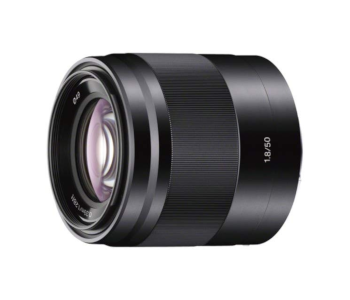 |
| Sony E 50mm f/1.8 OSS |
| 4.4/5.0 |
| Type: Telephoto prime |
| Image stabilization: Yes |
| Great for low-light and interior shots. |
| Check Amazon |
| Best Value |
|---|
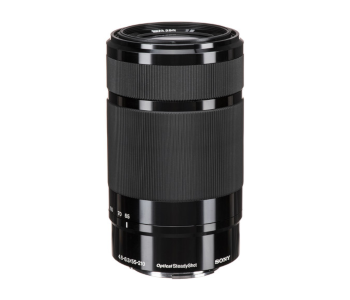 |
| Sony E 55-210mm f/4.5-6.3 OSS |
| 4.6/5.0 |
| Type: Telephoto zoom |
| Image stabilization: Yes |
| Controlled pincushion distortion. |
| Check Amazon |
| Top Pick |
|---|
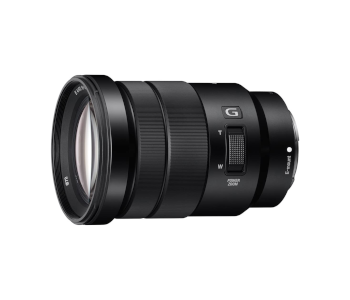 |
| Sony E PZ 18-105mm f/4 G OSS |
| 4.7/5.0 |
| Type: All-in-one zoom |
| Image stabilization: Yes |
| Autofocus is silent and quick. |
| Check Amazon |
Sony a6300 Lenses Comparison Table
| Image | Product | Overall Rating | Image quality | Build quality | Versatility | Price |
|---|---|---|---|---|---|---|
 | Sony E PZ 18-105mm f/4 G OSS | 4.7 | 4.6 | 4.6 | 4.8 | Check Price |
 | Sony E 55-210mm f/4.5-6.3 OSS | 4.6 | 4.5 | 4.6 | 4.7 | Check Price |
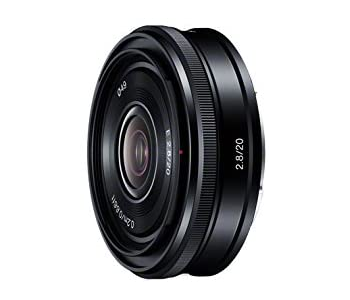 | Sony E 20mm f/2.8 | 4.5 | 4.7 | 4.4 | 4.3 | Check Price |
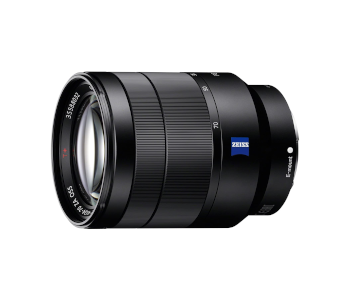 | Sony 24-70mm f/4 Vario-Tessar T FE OSS | 4.4 | 4.2 | 4.4 | 4.6 | Check Price |
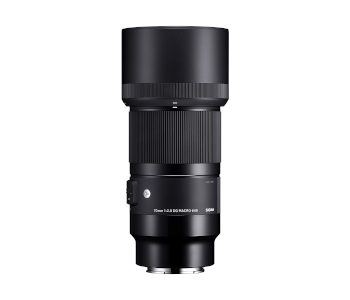 | Sigma 70mm f/2.8 DG Macro Art | 4.6 | 4.6 | 4.4 | 4.5 | Check Price |
 | Sony E 50mm f/1.8 OSS | 4.4 | 4.4 | 4.2 | 4.5 | Check Price |
1. Best Overall – Sony E PZ 18-105mm f/4 G OSS
Editor’s Rating: 4.7/5
The PZ 18-105mm f/4 G OSS is among the most versatile lenses we’ve ever tested. The wide focal length range makes it appropriate for subjects as diverse as landscapes on one end and wildlife photography on the other. It’s also a power zoom model ideal for owners of the a6300 who use it as a video camera. Best of all, you get all of this for a reasonable price.
Overview of Features
The first thing you’ll notice about the PZ 18-105mm f/4 G OSS is its ample size. The lens looks almost comical when attached to the a6300, but it’s not so heavy that the combo feels unbalanced. It’s a beautiful minimalistic model with a plastic shell and a single switch. The controller in question is a zoom rocker that pushes the corresponding ring to perform either faster or execute more precise zooms when filming.
The PZ 18-105mm f/4 G OSS impresses with fast autofocus considering its wide focal range. A fifth of a second is all it takes for it to acquire focus and keep targets looking good even if they move. There’s little hunting regardless of light levels, and the quiet nature of the linear motor is another feature that makes this lens an excellent buy for filmmakers. You’ll have to toggle between manual and automatic focusing on the a6300 itself as there’s no switch, and the ring zooms in and out when in AF mode.
The PZ 18-105mm f/4 G OSS has soft corners compared to its excellent central sharpness at f/4 18mm. The latter skyrockets at f/5.6 while the former receives a mild boost and keeps climbing until you reach f/11 and have to start dealing with diffraction. Corner softness continues to improve as you zoom the lens in while the center remains tack-sharp.
There’s some vignetting that never exceeds 1.5 stops, a good result for this lens type. Out-of-focus highlights have blurry borders that give them a dreamy appearance while color transitions in backgrounds are smooth. There’s no focus breathing, and you’ll encounter tolerable amounts of barrel distortion at the wide end.
What’s Bad About It?
The PZ 18-105mm f/4 G OSS suffers from severe pincushion distortion at 35mm onward. Tests put it at a whopping seven percent, meaning that RAW images will be unusable if you don’t apply a correction in Lightroom first. Chromatic aberration becomes more pronounced towards the edges at high apertures.
| Tech Specs |
|---|
| Dimensions: 3.1 x 3.1 x 4.3 in. |
| Weight: 15 oz. |
| Type: All-in-one zoom |
| Minimum focal length: 18mm |
| Maximum focal length: 105mm |
| Maximum aperture: f/2.8 |
| Minimum aperture: f/22 |
| Minimum focus distance: 1.5 ft. |
| Angle of view: 77° to 15° |
| Image stabilization: Yes |
| Pros |
|---|
| Great value for the money |
| An excellent choice for filmmakers and photographers alike |
| Autofocus is silent and quick |
| Low amount of vignetting for a lens of its kind |
| Cons |
|---|
| Severe pincushion distortion past 35mm |
| Noticeable chromatic aberration at high apertures |
2. Best Value – Sony E 55-210mm f/4.5-6.3 OSS
Editor’s Rating: 4.6/5
A6300 users who specialize in sports or wildlife photography need a longer maximum focal length than our winner provides and should go with the 55-210mm f/4.5-6.3 OSS instead. This smaller, lighter lens corresponds to 85-335mm in 35mm terms and also does well as a portrait or architecture lens at the short end. It’s a cheap alternative to Sony’s FE offerings and a quality one at that.
Overview of Features
We were most impressed with the 55-210mm f/4.5-6.3 OSS’s build quality. It’s remarkable how Sony managed to incorporate a magnesium alloy body and rubberized knurled rings into a lens that costs less than $350. Some compromises needed to be made as the lens isn’t weather-sealed. It does look much more at home when attached to an a6300 than the 18-105mm model, though.
Autofocus is based on contrast detection and driven by a linear motor. The lens does well speed-wise considering its old-fashioned acquisition method, and accuracy doesn’t suffer either. You can turn autofocus on for videos as the drive isn’t audible unless the room is completely quiet. Optical Steady Shot compensates for the a6300’s lack of image stabilization and noticeably improves your chances of landing keepers when shooting handheld.
The 55-210mm f/4.5-6.3 OSS’s sharpness is a mixed bag. It’s impressive at 55mm, where both the center and the periphery start off razor-sharp and continue to improve up to f/11. Increasing the focal length cuts into clarity, and the effect becomes stronger as you approach 210mm. Images shot at that focal length aren’t unusable, but the edges and corners are soft no matter which aperture you’re using.
Other optical properties redeem the 55-210mm f/4.5-6.3 OSS. It has small amounts of pincushion distortion throughout its range, which is curious as you’d expect barrel distortion at 55mm instead. Bokeh at f/4.5 exhibits some onion rings, but backgrounds blend together nicely. You’ll have no issues with artifacts and flares, especially if you attach a 49mm polarizer and the deep circular lens hood.
Are There Drawbacks?
A soft periphery might be reason enough for some users to avoid the 55-210mm f/4.5-6.3 OSS. Chromatic aberration is another one. It’s visible at all focal lengths and fluctuates between one and two pixels in width, depending on the aperture. Shooting JPEGs or cleaning RAWs in post will get rid of it.
| Tech Specs |
|---|
| Dimensions: 2.5 x 2.5 x 4.3 in. |
| Weight: 12.2 oz. |
| Type: Telephoto zoom |
| Minimum focal length: 55mm |
| Maximum focal length: 210mm |
| Maximum aperture: f/4.5 to 6.3 |
| Minimum aperture: f/22 to 32 |
| Minimum focus distance: 3.3 ft. |
| Angle of view: 29° to 7° 40′ |
| Image stabilization: Yes |
| Pros |
|---|
| Excellent build quality for its price |
| Lightweight and balanced |
| Controlled pincushion distortion |
| Accurate autofocus |
| Cons |
|---|
| Drop in sharpness as you zoom in |
| Pronounced chromatic aberration |
3. Sony E 20mm f/2.8
Editor’s Rating: 4.5/5
Sony’s svelte wide-angle prime is the perfect choice for novice photographers who’ve been relying on their smartphone’s camera before getting the a6300. Its 32mm equivalent angle is useful for landscapes, group shots, and architectural photography, while silent operation makes it an excellent choice for movies. Add great image clarity, and you’ve got a versatile lens every a6300 user should add to her arsenal eventually.
Overview of Features
The 20mm f/2.8 is a featherweight pancake lens that barely adds weight and width to your camera & can comfortably reside in a jacket pocket when not in use. It has a glossy finish and is made of plastic. There’s no image stabilization, and six glass elements in as many groups barely contribute to its weight. You get an equally compact hood that easily attaches to the lens and increases its already formidable flare resistance.
Autofocus on the 20mm f/2.8 is hit and miss. On the one hand, it’s as smooth and quiet as on any other Sony E lens. On the other, it can struggle to lock onto targets and takes several tries to settle. This won’t be an issue for landscape or food photos but might upset movie makers. The manual focus ring is narrow due to the lens’s size limitations. Luckily, it is nicely-damped and lets you precisely control focus.
We were pleased with the 20mm f/2.8 sharpness. Results at max aperture aren’t stellar, but they’re uniform from corner to corner. The trend continues as you step down as sharpness strives for and eventually reaches excellent levels at f/8. Going with f/11 is fine as diffraction starts to become problematic only on the minimum aperture.
Ordinary and veiling flare isn’t an issue, which makes the 20mm f/2.8 a solid choice for landscapes that involve the sun. A high max aperture allows for shallow depth of field and produces creamy bokeh. This isn’t a macro lens, but you can get close to subjects and use the DOF to your advantage. Chromatic aberration is present but not problematic. There’s some barrel distortion, but that’s true for all wide-angle lenses.
What We Didn’t Like
The 20mm f/2.8 exhibits strong vignetting when wide open. Corners are 2.5 stops darker than the center and don’t step in line until you’re at f/8.There’s no weather sealing, which is a shame considering the lens excels at outdoor photography.
| Tech Specs |
|---|
| Dimensions: 2.5 x 2.5 x 0.8 in. |
| Weight: 2.4 oz. |
| Type: Wide-angle prime |
| Focal length: 20mm |
| Maximum aperture: f/2.8 |
| Minimum aperture: f/16 |
| Minimum focus distance: 3.3 ft. |
| Angle of view: 70° |
| Image stabilization: No |
| Pros |
|---|
| Lightweight and portable |
| Responsive focus ring |
| Uniform sharpness that gets better as you step down |
| Excellent resistance to flares |
| Cons |
|---|
| No weather sealing |
| Pronounced vignette at f/2.8 |
4. Sony 24-70mm f/4 Vario-Tessar T FE OSS
Editor’s Rating: 4.4/5
A standard zoom is among the first purchases you should make when you outgrow your a6300’s kit lens. The 24-70mm f/4 Vario-Tessar T FE OSS is the one to get if you’re after imaging excellence and have the money to spare. It’s a smart choice as it covers product and cityscape photography along with portraits and events. A working photographer using it will find herself with wowed customers and a paid-off lens in no time.
Overview of Features
The 24-70mm f/4 Vario-Tessar T FE OSS is a Zeiss lens, which speaks volumes about its quality. It has an all-metal alloy body that’s lighter than you’d expect from a lens with 12 elements, including one made especially to keep glare to a minimum. The lens is weather-sealed and ready to perform under unforgiving temperatures, whether hot or cold.
Sony uses a linear autofocus motor to silently put the 24-70mm f/4 Vario-Tessar T FE OSS’s subjects into view. Its speed is above average for a lens with a maximum aperture of f/4, as is its low-light performance given the same limitation. Focusing manually is a treat since the ring is ridged and either fast or accurate, depending on the turning speed. The lens has Optical Steady Shot that comes in handy when you’re tracking subjects through the viewfinder or going for longer exposure times without a tripod.
The 24-70mm f/4 Vario-Tessar T FE OSS’s sharpness tells an interesting story. On the one hand, you’ve got jaw-dropping central sharpness that persists as you play with the aperture size and focal range. On the other, edges and especially the corners hang behind, reaching only good results that improve modestly when you step down. The lens’s sweet spot lies between f/8 and f/11.
Flare resistance is particularly effective at 24mm and deteriorates only slightly as you zoom in. Nothing some readjustment can’t fix. There’s some lateral chromatic aberration in the corners you’ll notice only at max aperture and f/5.6. The lens can create smooth out-of-focus backgrounds with highlights that take on the cat’s eye shape the closer they are to the edges.
What We Didn’t Like
The 24-70mm f/4 Vario-Tessar T FE OSS displays considerable vignetting. It can reach three stops if uncorrected for, which you’ll want to address by using Lightroom or decreasing the aperture. Longitudinal aberration isn’t as easy to combat. It’s manifested as color fringing around contrasting highlights and barely gets better with stepping down. Avoid using a shallow depth of field in scenes with lots of lights or the sun reflecting off of waves to mitigate this.
| Tech Specs |
|---|
| Dimensions: 2.9 x 2.9 x 3.7 in. |
| Weight: 15 oz. |
| Type: Standard zoom |
| Minimum focal length: 24mm |
| Maximum focal length: 70mm |
| Maximum aperture: f/4 |
| Minimum aperture: f/22 |
| Minimum focus distance: 1.3 ft. |
| Angle of view: 84.1° to 34.3° |
| Image stabilization: Yes |
| Pros |
|---|
| Versatile focal length |
| Outstanding central sharpness |
| Exceptional build quality and weather sealing |
| Precise focus ring |
| Cons |
|---|
| Strong vignetting |
| Pronounced LoCA |
5. Sigma 70mm f/2.8 DG Macro Art
Editor’s Rating: 4.6/5
Sony makes fantastic macro lenses, but we’re giving the win to Sigma as its 70mm f/2.8 DG Macro Art pairs best with the a6300. The FE 90mm f/2.8 Macro G OSS and FE 50mm f/2.8 Macro are solid alternatives, but the first costs more than your camera while the second has a short minimum focusing distance. Sigma’s lens is among the sharpest we’ve seen, has an optimum focusing distance, and is affordable to boot.
Overview of Features
The 70mm f/2.8 DG Macro Art was initially intended for use with SLR bodies. The E mount version has a special metal mounting piece that makes it compatible with the a6300. It’s a well-built lens with a polycarbonate barrel and responsive focus ring. The mount has a rubber gasket that increases the lens’s moisture and dust resistance. You get two lens caps and a hood with it and can attach 49mm filters to its front element.
This is one of the sharpest macro lenses we’ve ever tested. Its performance is already remarkable at f/2.8 where the 70mm f/2.8 DG Macro Art is tack sharp across the frame. Strangely, sharpness dips slightly at f/4 but picks up the pace at f/5.6. Peak performance is reached at f/8, and clarity is so good that you can use it at f/16 despite diffraction.
This is a true macro lens that reproduces subjects at a 1:1 ratio when they’re 10.2 inches away from it. The internal barrel extends when focusing and has markings that show the current magnification and focus distance. Clarifying the image manually is easy thanks to a wide and textured ring. It offers the right amount of resistance for pin-point accuracy. The only issue is its wide throw; you’ll have to rotate the ring several times to go from minimum focusing distance to infinity.
We’re pleased to report that chromatic aberration is nowhere to be seen. Out-of-focus highlights display lovely uniformity thanks to the 70mm f/2.8 DG Macro Art’s rounded nine-blade diaphragm. There’s no distortion whatsoever either, so you’ll love using Sigma’s lens for portraits or cityscapes when you aren’t snapping pictures of small things.
What’s Bad About It?
The 70mm f/2.8 DG Macro Art’s autofocus is slow since it isn’t performed internally. It takes three seconds for it to acquire focus if you’re going for infinity from 10.2 inches. A focus limiter switch helps, but results are still disappointing. Image stabilization is helpful for achieving crisp macro shots, and this lens doesn’t have any.
| Tech Specs |
|---|
| Dimensions: 2.8 x 2.8 x 4.2 in. |
| Weight: 18.2 oz. |
| Type: Macro lens |
| Focal length: 70mm |
| Maximum aperture: f/2.8 |
| Minimum aperture: f/22 |
| Minimum focus distance: 10.2 in. |
| Angle of view: 34.3° |
| Image stabilization: No |
| Pros |
|---|
| Optimum focusing distance and true 1:1 magnification |
| Exceptionally sharp |
| No CA or distortion |
| Creates dreamy bokeh |
| Cons |
|---|
| Slow autofocus |
| No image stabilization |
6. Best Budget Option – Sony E 50mm f/1.8 OSS
Editor’s Rating: 4.4/5
The E 50mm f/1.8 OSS is the first optically stabilized telephoto prime with an aperture of f/1.8. It offers buttery smooth blurred-out backgrounds that complement its main purpose – portrait photography. Shallow depth of field combined with great low-light performance makes the lens a must-buy for photographers who make model portfolios and preserve life’s fondest memories.
Overview of Features
The E 50mm f/1.8 OSS is an affordable prime lens made from aluminum. It has a barebones build as a textured focus ring is all you can control. The lens is available in black or silver, and both versions look attractive. It’s not as compact as the pancake lens reviewed earlier, but its square shape and small form factor ensure the E 50mm f/1.8 OSS won’t clutter your photography bag.
This is one of the fastest lenses in Sony’s entire lineup, both in terms of focus acquisition and aperture size. Its effective combination of lightning-fast AF motor and wide aperture makes subjects sharp nearly instantly while isolating them from the background. Best of all, the lens doesn’t let up in low light, which makes it a top-tier choice for concerts and other indoor events. OSS provides three stops of image stabilization. It’s not as effective as IS systems by Sony’s rivals, but it improves handheld shooting and video recording alike.
Central sharpness at f/1.8is great while edges & corners are within acceptable limits. The situation remains the same at f/2.8, but things take a turn for the better at f/4 as all values soar. F/5.6 is as good as it gets for the center while the periphery keeps getting better until f/8. Diffraction becomes pronounced past f/16 and degrades image quality.
The E 50mm f/1.8 OSS displays a marginal amount of pincushion distortion, not even half a percent. Fast primes are prone to longitudinal chromatic aberration, but here it’s a slight issue you can get rid of by the time you reach f/2.8. The lens accepts polarizers and has a deep hood, so flares aren’t problematic either.
Are There Drawbacks?
Both of the Sony E 50mm f/1.8 OSS‘s shortcomings can be corrected. The first is moderate, 1.5-stop vignetting at f/1.8. The other is CA that starts at a width of 1.5 pixels and then decreases only to rise again as you approach f/22. Your a6300 will take care of vignetting, while CA is a matter for post-processing.
| Tech Specs |
|---|
| Dimensions: 2.5 x 2.5 x 2.5 in. |
| Weight: 7.2 oz. |
| Type: Telephoto prime |
| Focal length: 50mm |
| Maximum aperture: f/1.8 |
| Minimum aperture: f/22 |
| Minimum focus distance: 1.3 ft. |
| Angle of view: 32° |
| Image stabilization: Yes |
| Pros |
|---|
| Fast prime with quick autofocus |
| Great for low-light and interior shots |
| Negligible pincushion distortion |
| Effective image stabilization. |
| Cons |
|---|
| Some vignetting and chromatic aberration |
Contents
- Sony a6300 Lenses Comparison Table
- 1. Best Overall – Sony E PZ 18-105mm f/4 G OSS
- Overview of Features
- What’s Bad About It?
- 2. Best Value – Sony E 55-210mm f/4.5-6.3 OSS
- Overview of Features
- Are There Drawbacks?
- 3. Sony E 20mm f/2.8
- Overview of Features
- What We Didn’t Like
- 4. Sony 24-70mm f/4 Vario-Tessar T FE OSS
- Overview of Features
- What We Didn’t Like
- 5. Sigma 70mm f/2.8 DG Macro Art
- Overview of Features
- What’s Bad About It?
- 6. Best Budget Option – Sony E 50mm f/1.8 OSS
- Overview of Features
- Are There Drawbacks?

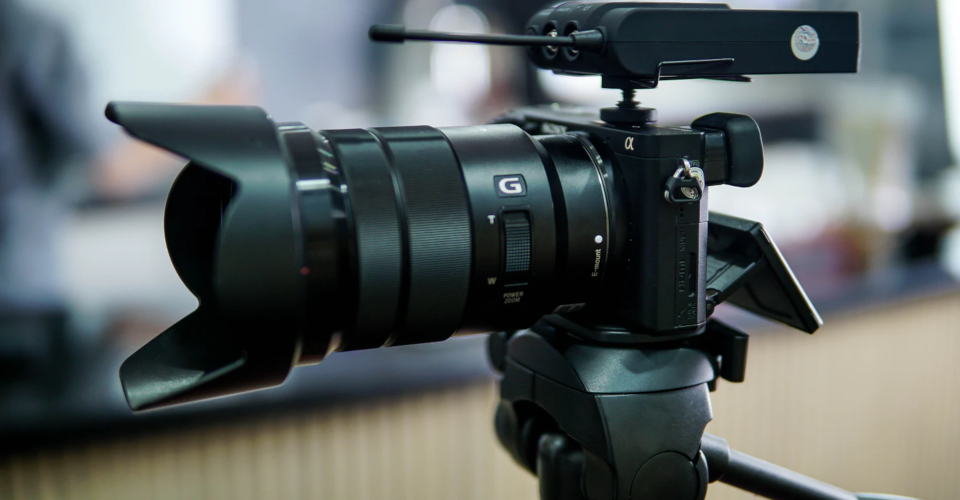
It’s hard to say